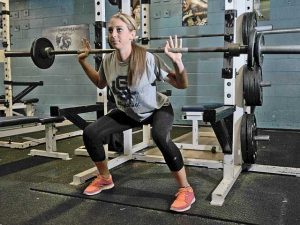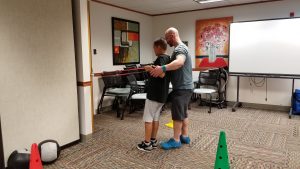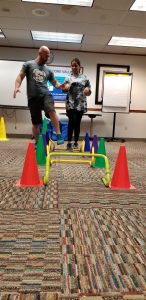We’ve all heard the old adage “A Jack of all trades is a master of none”.
This holds true to nearly every aspect of life, including the role many of us have assumed as a youth strength and conditioning coach.
In becoming a youth coach, we’ve definitely narrowed down our focus of mastery. However, within “youth” there are now more varied needs than  ever. Sport coaches, classroom teachers, and parents are now looking for specific solutions to the specific needs of niche populations within youth.
ever. Sport coaches, classroom teachers, and parents are now looking for specific solutions to the specific needs of niche populations within youth.
These niche populations may not be served effectively under the “come all” strength and conditioning program model many offer within their facilities and institutions. Strength and conditioning coaches willing to be in tune with, and master, solutions to specific needs within their community have an opportunity to change the message of their program from “We can help A child” to “We can help YOUR child”.
As you can see, the latter is a much stronger message and mission if I’m a parent or organization selecting a program for my young athlete(s). This makes your program not merely “A” program available. It makes it “THE” program available for a specific demographic. The result is an ever-growing, long-term, successful program with a uniquely positive impact on the community.
Consider the 4 youth niches below that may represent underserved needs within your community.
5-8 Year Old Athletes
Despite the ages of 6-12 representing some of the most critical years for motor development, few quality development programs are available for the youngest cohort in this age range. There was a time that physical education took care of these kids, but statistics suggest that is no longer the case.
Many professionals shy away from working with young children due to inexperience, lack of patience with short attention spans, and children’s largely unfocused, endless energy. With proper training, resources, and experience however, this energy can fuel a fun and engaging program for this demographic of kids who need it the most.
While many shy away, tremendous opportunities exist for those who are knowledgeable, passionate, and focused on helping grade school age children.
Female Athletes
 Fortunately, sports are not the “boys club” they once were. Sports participation amongst young women and girls is at an all-time high. Despite this increase, young women’s access to quality strength and conditioning programs is often limited compared to their young male counterparts. Due to an inaccurate cultural convention, misinformed coaches, and a variety of other factors, strength training has not traditionally been embraced as part of young female athlete culture.
Fortunately, sports are not the “boys club” they once were. Sports participation amongst young women and girls is at an all-time high. Despite this increase, young women’s access to quality strength and conditioning programs is often limited compared to their young male counterparts. Due to an inaccurate cultural convention, misinformed coaches, and a variety of other factors, strength training has not traditionally been embraced as part of young female athlete culture.
Coaches that create exclusive opportunities to educate young female athletes and their communities about the importance of strength training for performance and injury prevention have the opportunity to stand out in a crowded market.
Athletes with Special Needs
A growing number of youngsters are being diagnosed as “special needs” due to behavioral or developmental pathology. These kids benefit greatly from exercise programs, however, few coaches have experience or expertise with this demographic.
A variety of courses, certifications, and other educational opportunities are becoming available for those looking to help these kids. Programs that specialize in working with athletes with autism, ADHD, and other special needs offer a much-needed service to an underserved population.
Homeschooled Children
Nearly 2 million children are homeschooled in the United States. These kids have standard academic requirements that include physical education. They also participate in sports. Parents of homeschooled children often struggle when it comes to creating a physical education curriculum for one child.
 Additionally, homeschool parents are challenged with finding opportunities for their kids to socialize with other kids during school hours.
Additionally, homeschool parents are challenged with finding opportunities for their kids to socialize with other kids during school hours.
Coaches and facilities that are in tune with the needs of homeschooled kids and parents have an opportunity to offer a needed service with little to no market competition. Additionally, these kids are not bound by the hours of the typical academic day. Groups and classes can be run during the typically “slow” hours in the morning or early afternoon.
Serving these special niches requires more than merely adding a class to your schedule. Parents, coaches and communities value experts. An expert will prompt a parent to overcome the barriers of money, transportation, and time to bring their child to a program.
If you are looking to grow your programs by becoming an expert that serves a niche, ask yourself these questions:
- What are the specific aspirations/fears of the parents/athletes associated with this niche?
- What education/experience is necessary to serve this niche?
- Why are you passionate and committed to serving this specific population?
- What are the needs outside of exercise that could be addressed with these kids/parents?
- What key organizations could you create a relationship with that could act as a referral or endorsement for your program?
- Who are others that have created programs for this specific demographic?
The answers to these questions can help you and your business increase your success and positive impact within your community.

Brett Klika is a youth performance expert and a regular contributor to the IYCA who is passionate about coaching young athletes. He is the creator of the SPIDERfit Kids youth training program and has run successful youth fitness programs all over the country. Brett is an international speaker whose passion for youth fitness has helped thousands of people learn how to create exceptional training experiences for young athletes.
If you want to be better at coaching young athletes, the IYCA Youth Fitness Specialist certification is the industry gold-standard for youth fitness and sports performance. Click on the image below to learn more about the YFS1 certification program.


 those with autism and related disorders, need consistency and repetition. A push throw is always going to be a push throw. We should adhere to a Lord of the Rings rule; “One label to rule them all.”
those with autism and related disorders, need consistency and repetition. A push throw is always going to be a push throw. We should adhere to a Lord of the Rings rule; “One label to rule them all.”  Eric Chessen, M.S., is the Founder of
Eric Chessen, M.S., is the Founder of 